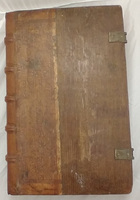Rare Books: A Glossary
Quarter bound — Ruling
Quarter bound: A binding style where the spine and part of the boards are bound in one material while the rest of the cover is bound in another material (or left unbound).
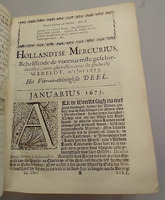
Quarto: A book format, commonly abbreviated 4º. The quarto requires two folds to produce and is usually squarish in shape, though this may vary based on the dimensions of the original sheet of paper. A quarto gathering usually has four leaves (i.e., eight pages) but a quarto gathering produced through half-sheet imposition will have two leaves (i.e., four pages).
Image: Hollandse Mercurius. Haerlem: Gedruckt by A. Casteleyn [etc.], 1673-1676. D1 .H82 (1673-1676) pt.24-27
Quarto: A book format, commonly abbreviated 4º. The quarto requires two folds to produce and is usually squarish in shape, though this may vary based on the dimensions of the original sheet of paper. A quarto gathering usually has four leaves (i.e., eight pages) but a quarto gathering produced through half-sheet imposition will have two leaves (i.e., four pages).
Quire: One-twentieth of a ream of paper, or 25 sheets (though the exact number of sheets in a quire may vary by the place and time of manufacture). To a binder, this is another word for a gathering.
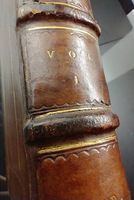
Raised bands: The ridges on the spine of some books. Originally, these were created by the sewing supports, which wrapped around the spine of the book. When binding techniques changed to favor recessed sewing supports (where the sewing supports rested in grooves cut into the text block), binders started creating false raised bands to suit their clients’ old-fashioned tastes. (In England, this started happening in the early 17th century.) Raised bands do not always match the locations of the actual sewing supports.
Image: Ovid, 43 B.C.-17 A.D. or 18 A.D. Fasti. Lyon: Antonius Gryphius, 1574. PA6519 .A2 1566
Raised bands: The ridges on the spine of some books. Originally, these were created by the sewing supports, which wrapped around the spine of the book. When binding techniques changed to favor recessed sewing supports (where the sewing supports rested in grooves cut into the text block), binders started creating false raised bands to suit their clients’ old-fashioned tastes. (In England, this started happening in the early 17th century.) Raised bands do not always match the locations of the actual sewing supports.
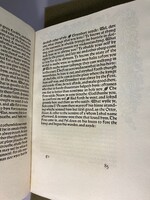
Recto: The side of a leaf that is visible when the leaf is on the right-hand side of the codex. (The other side of a leaf, when it is on the left, is the verso side.) In broadsides and single sheets of paper, the recto side is usually considered to be the “front.”
Image: Reynard the Fox. English. Hammersmith: Kelmscott Press, sold by B. Quaritch, London, 1893. PT5584 .E5 C33 1893
Recto: The “front” of a leaf of paper. In books that are written from left to right (as in European languages), this is the page on the right-hand side of the codex. In books that are written and read from right to left (as in Arabic, Hebrew, and many Asian languages), the recto is on the left-hand side and the verso is on the right-hand side. The other side of a leaf is the verso side.
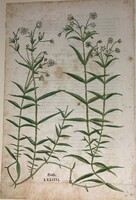
Relief printing: A term for illustration processes where a design is raised above the rest of the material it is attached to, i.e., everything except the design has been cut away. Relief printing is the opposite of intaglio printing. Common forms of relief printing include woodcuts, wood engraving, and movable type.
Image: Leonhart Fuchs in Kräuterbücher aus fünf Jahrhunderten: 50 Originalblätter aus deutschen, französischen, niederländischen, englischen, italienischen und Schweizer Kräuterbüchern. München: Wölfe, 1956. QK99.G3 K7 1956
Relief printing: A term for illustration processes where a design is raised above the rest of the material it is attached to, i.e., everything except the design has been cut away. Relief printing is the opposite of intaglio printing. Common forms of relief printing include woodcuts, wood engraving, and movable type.

Roman type: A style of type, prevalent at first in southern Europe and now throughout the Western world. Roman type is distinct from blackletter type (which tends to be blockier) and italic type (which tends to be fancier and more slanted).
Image: Wilson, Alex., & Sons, type-founders. A specimen of printing types. Glasgow: 1783. Z250 .W74 1783. Digitally available at the MU Digital Library.
Roman type: A style of type, prevalent at first in southern Europe and now throughout the Western world. Roman type is distinct from blackletter type (which tends to be blockier) and italic type (which tends to be fancier and more slanted).
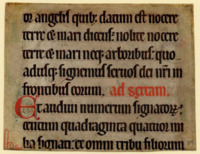
Rubrication: The practice of highlighting special letters or words by using colored ink, usually red or blue, rather than black. Initials in particular tend to be rubricated. In manuscript production, this was a specialist area of scribing and it was done after the rest of the text was completed. Because of the challenges in printing books in multiple colors, early printers also hired rubricators but eventually replaced rubricated initials with woodcuts.
Image: Breviary (Fragmenta Manuscripta 89). 1240-1260. Z109 .F73. Digitally available at the Digital Scriptorium.
Rubrication: The practice of highlighting special letters or words by using colored ink, usually red or blue, rather than black. Initials in particular tend to be rubricated. In manuscript production, this was a specialist area of scribing and it was done after the rest of the text was completed. Because of the challenges in printing books in multiple colors, early printers also hired rubricators but eventually replaced rubricated initials with woodcuts.
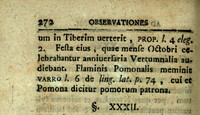
Rule: A decorative printed line created by a metal strip, also called a “rule.” Rules were often used to create borders on a printed page.
Image: Schwarz, Christian Gottlieb, 1675-1751. Observationes ad Guil. Henr. Nieupoorti compendium antiquitatem romanarum praemisa brevi. Altdorf: Lorenz Schupfel, 1757. DG81.N68 S5
Rule: A decorative printed line created by a metal strip, also called a “rule.” Rules were often used to create borders on a printed page.
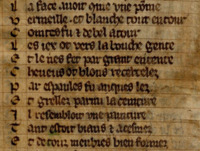
Ruling: A manuscript practice of drawing lines to make it easier for a scribe to keep the lines of their text level. Sometimes ruling was done in lead; sometimes it was done by just drawing a line in the paper or parchment with a hard metal tool to leave a groove.
Image: Jean de Meun, approximately 1240-approximately 1305, Guillaume de Lorris, active 1230. Fragment from Roman de la Rose (Fragmenta Manuscripta 156). 1300-1350. Z109 .F73. Digitally available at the Digital Scriptorium.
Ruling: A manuscript practice of drawing lines to make it easier for a scribe to keep the lines of their text level. Sometimes ruling was done in lead; sometimes it was done by just drawing a line in the paper or parchment with a hard metal tool to leave a groove.
